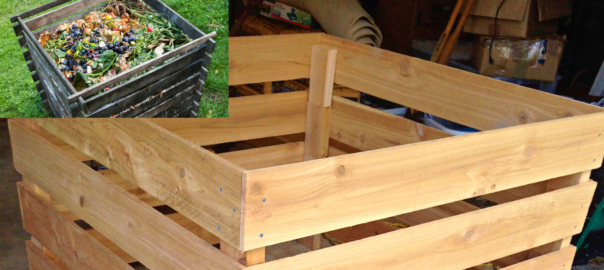In a recent newsletter post I shared the picture above. It's a compost bin that my husband built because we needed another one in the yard. We had two, a tumbling bin, which we use to put kitchen scraps into, and a fixed bin which we use for finishing the compost when the tumbler gets too full for me to turn it easily. This way we always have a bin for household scraps and the finishing bin is great to let it sit a while longer either until it's done or until we can use it.
Now that we have a larger yard though, we're generating more compost from weeds and such. The tumbling bin can only hold so much and the finishing bin works best if we put partially decomposed stuff into it. So we needed a new one.
My husband went searching online and found this bin and the plans. He easily made ours following the instructions given on the website. The challenge with a lot of bins is getting to the compost when it's done. We love the stackable/unstackable feature which will make it very easy to access compost when it's ready. You add layers as the bin gets higher. Then you unstack them as you're using it.
Several people asked for more information about compost. Here's what I know and what works for us:
In the house we have a small, lidded kitchen trashcan (with foot pedal because when your hands are full of kitchen scraps you can't open the lid at the same time). My mom taught me a good trick and we line the bottom with a paper towel, shred some newspaper into it and top with another paper towel. This serves a couple of purposes.
First, it soaks up most of the liquid if you put wet-ish things in there like melon rinds.
Second, it adds some brown matter and improves the brown to green ratio (more on that below). And compost needs both brown and green matter in order to break down properly.
Third, it makes things slide out of the bin and into the compost tumbler very easily. In the past if things started to break down too quickly they got a little sticky and it wasn't so pleasant to have to scrape the bin clean.
What do we put in our compost bin?
Everything we can. Egg shells, potato peelings, fruit and veggie rinds, and things that are past their prime (although we try to not have too many of those). As long as it is not dairy or meat it goes in the bin. We don't put my husband's coffee grounds in there, although we could, because we use those straight on the roses. We also do not add grass as we have a mulching attachment on our lawn mower and use that to help fertilize the lawn.
We do use dry leaves in the compost bin. If you just have green matter your compost gets very stinky. It also attracts a lot of flies. An ideal bin would be 30 parts brown matter (which provides carbon) to 1 part green matter (which provides nitrogen). Most websites that I've found seem to indicate that kitchen scraps are about 12 or 15:1. Dry leaves are 50:1. I think my paper lined bin is possibly closer to 20:1. Sometimes my husband has sawdust leftover from a project (like making a compost bin) and we can add that. We try not to over-think it but if we notice it's not breaking down well we try to adjust.
I do not compost manure in the bins. While I am expecting a trailer-load of horse manure any day now, that will sit in a separate pile to do it's thing until it's ready; it needs to rest for a while as horses are not very efficient digesters and if you use it right away it's too hot and too weedy. It needs to break down for a while. I don't use pet manure in the compost, that gets buried in the yard in an area where we don't grow food.
Compost bins also need moisture. We've been getting enough rain and it seems to seep into the bins. And I figure there's enough moisture in what we're putting into the bin. If it looks a little dry as the summer progresses and the heat increases we'll adjust the moisture content as needed. Again, we try not to be too picky about it but to pay attention to what things look like.
Once your compost is done (and there's something really amazing and wondrous about turning garbage into rich, crumbly soil) it's great to use in the garden. I top dress my garden beds with it in the Spring and the Fall. It's also good for putting into containers when I repot them. At this point I have more of a need than I have available supply. This new bin is definitely going to be put to good use.



